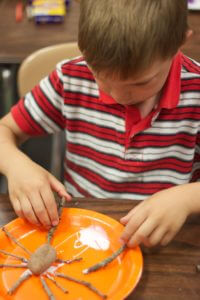Lesson Overview
This lesson helps young people understand the benefits of outside play for their bodies and minds. The youth will participate in three hands-on activities that show some of the many ways they can enjoy being outdoors.
Instructor Notes
Before facilitating this lesson, you may want to review the following information about the benefits of outdoor play. These facts can be shared with young people during your discussions.
Outdoor play can help the body by:
- increasing fitness levels and building active, healthy bodies
- raising levels of Vitamin D which helps protect bone strength and may help in the prevention of chronic diseases such as heart disease and diabetes
- may help improve distance vision
- may help you breathe easier.
Outdoor play can help the mind by:
- improving focus throughout the day
- helping kids score higher on tests
- improving critical thinking on projects.
Outdoor play can help the spirit by:
- lowering stress levels
- protecting emotional development and lowering the risk of anxiety and depression
- enhancing social interactions and helping kids value community
- enhancing sleep duration and quality.
Activity: Outdoor Energy Boost
This activity demonstrates how our mood can improve simply by going outdoors for a short period of time.
- Before going outside, have each young person report on how they are feeling. Write their answers on the whiteboard or smart board.
- When they come back inside, ask them again how they are feeling. Write their answers down again. Ask the youth what differences they see. Do they feel happy or sad, tired or lively, restless or calm? Did they feel like they have more energy since going outside?
- After all the results are in, show the young people some of the differences. For instance if 5 people were tired before going outside, and 1 was tired after going outside, then you can form a hypothesis that going outside makes most people less tired. If your group of young people would rather play on the computer or watch TV, let them know that these ‘screen’ activities could make them feel more tired and less energetic. So, the more you are able to get outside creating, playing, and working the more energy you will have.
- Tell them some of the positive benefits of outdoor play, such as builds healthy bones, improves mood, fresh air can help us breathe easier, and help us sleep better at night.
Activity: Creature – An Outdoor Art Project
This activity allows youth to use their imagination and creativity to look at nature in a whole new way.
- Give each young person a paper bag to bring outside to collect treasures. Tell them they will be making a creature/bug/monster when they have all their supplies.
- Have them think about the creature they want to make, then offer clues like collecting a rock for the body, twigs for legs, leaves for wings, and tree seeds for scales. Let them be creative.
- Once all the supplies are collected, have the youth glue their creature together and allow time to dry. Have each young person show and tell about their creatures.
Activity: Dig in the Dirt
Most children do not even know what soil ‘feels’ like, they walk on sidewalks. Some days kids do not even get to walk on grass, most have never gardened. This activity has proven to slow kids down and ground them, meaning to get them back to the basics of earth, away from technology. Spending time feeling, touching and describing soil and other nature made materials has been proven to reduce stress and anxiety.
- Have a bucket of soil for the young people to feel the texture.
- Have the young person describe the feeling.
- Write their descriptions on the board.
Conclusion
Remind young people that playing outside has many benefits for their bodies and minds. Ask the youth to brainstorm other fun activities they can do outside. Encourage them to get outside and enjoy the outdoors everyday!
Continuing the Conversation
Hand out the Healthy Families Newsletter in English or Spanish, so that families can discuss ways to get outside and have fun together.
Related Health Powered Kids Blog
Exercise to help the body, mind and spirit
Additional Instructor Resources
Book: Growing Vegetable Soup, by Lois Ehlert
Outdoor Activity Finder by the National Wildlife Federation

